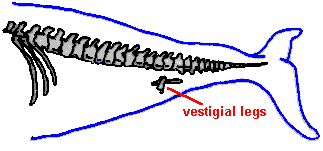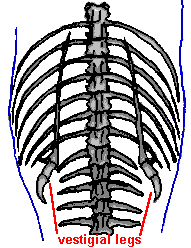(Seals and sealions have small legs that aren't quite useless so they aren't quite vestigial.)

Hair!
Whales and dolphins have a small amount of hair. Usually this
is nothing more than a few bristles around their mouth or on their
face.
|
These sea mammals also have vestigial legs! Buried deep inside
their "hip" is a pair of very tiny legs complete with
femurs. They never use them and have no need for them because
they never come out of the water.
(Seals and sealions have small legs that aren't quite useless so they aren't quite vestigial.) | 
|
Why would a whale or dolphin have tiny legs or any legs at all
unless it was an old "hand me down" from its ancestors?
The tiny legs do them no harm but they don't help them either.
They are vestigial.
|
How about another example?
Snakes evolved from four legged animals similar to lizards. Most species of snakes have lost all traces of limbs but snakes in the boa and python family have a tiny pair of hind legs. Unlike whales the python's (or boa's) vestigial legs can actually be seen as a pair of "spurs" that stick out where the body ends and the tail begins. (Admittedly, it is difficult for an untrained person to tell where that is!) | 
|
Vestigial organs are merely "hand me downs" and they rarely do any harm. They are nothing more than useless homologous structures. Evolution works with the "materials" at hand and adapts it to a purpose. If the structure loses its purpose, because the organism no longer uses it, the selection forces that would normally keep the structure in shape are no longer active. Then the structure is free to accumulate useless mutations that often cause the structure to shrink and perhaps even disappear entirely.
These vestigial structures disprove Paley's theory of Natural Theology. If a designer were building whales and snakes from scratch, why would he include useless legs? It doesn't make sense.
"Lamarckians" argue that a whale ancestor lost the use of its legs and passed that trait (useless legs) to its descendants. Fans of Lamarck would argue that vestigial structures are proof of evolution through the Inheritance of Acquired Characteristics but they would be wrong. First, it is very difficult to prove a theory. (Right?) All you need to disprove a theory, such as Lamarck's, is to find evidence that disproves it, like all the evidence you learned about earlier in which experiments showed that acquired characteristics are not inherited. (Remember circumcision, mice with tails cuts off, etc.?)
"Darwinians" argue that a whale ancestor developed a mutation that gave it short legs but that the forces of selection didn't bother removing that mutant from the population because short legs were no problem to that sea living mammal. Indeed, the short legs could have been a big help! So the "short leg mutation" was passed to offspring and their descendants gave rise to the entire whale family.
I must admit that it isn't easy to strongly argue against Lamarckians with this whale evidence but my point is that we have rejected Lamarck, anyway (earlier) due to other evidence. Darwinian theory, the only theory that has withstood the tests of science, gives a reasonable explanation for vestigial structures.
Paley's theory of Natural Theology (designer) cannot
explain vestigial structures at all. Indeed, the "battle"
between Natural Theology and Natural Selection can be decided
entirely by referring to vestigial structures.
We can take that argument even further with more evidence.
If a designer were building species from scratch he would have
made those organisms efficiently and relatively error free (assuming
the designer wasn't an idiot).
Paley would not be able to explain the many errors in organisms.
I'm not talking about birth defects or disease. I'm referring
to "normal" errors that all organisms, even humans,
are born with.
Consider humans and our evolution.
Many millions of years ago our ancestors walked on all four limbs, like a dog or monkey. Eventually our ancestors started to walk up right on the hind feet. That allowed our hands to be free and that was a strong, positive selection pressure. Natural selection favoured those prehumans who walked upright because they had their hands free to build tools, carry game and do many other useful things with their hands and fingers. But we, the descendants of those early apes, pay a price for having given up our four legged walk. The organs in our body were "built", by Natural Selection over millions of years, to be in a horizontal position (parallel to the ground). Now we have our organs arranged vertically like a tower. Natural selection was quick to promote an upright walk in order to free the hands but it did not redesign everything to compensate for the new posture.
Can you think of some medical problems caused by our upright posture?
Think about injuries that might occur while doing something that
seems so natural - like lifting a heavy object.
Don't strain yourself thinking about it but give it some thought and then move on to the next page.
 and
and  licensed under a Creative Commons Attribution-ShareAlike 4.0 International License.
licensed under a Creative Commons Attribution-ShareAlike 4.0 International License.